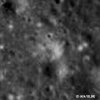PANAJI: A camera on board India's maiden unmanned lunar mission Chandrayaan-1 has recorded images of the landing site of US spacecraft Apollo 15,
a scientist said on Wednesday, rubbishing conspiracy theories that the fourth US mission to land on the moon four decades back was a hoax.
The Terrain mapper camera on board Chandrayaan-1, which had an abrupt end a few days back, has sent the prints of landing site of Apollo 15 and tracks of the lunar rovers used by astronauts to travel on lunar surface, a senior scientist associated with India's lunar mission said during a presentation here.
"The images captured by hyper spectral camera fitted as a part of Chandrayaan-1 image payload has reconfirmed the veracity of Apollo 15 mission," said Dr Prakash Chauhan, who is a senior scientist with Indian Space Research Organisation's(ISRO) Hyderabad-based space application centre.
Chauhan was presenting the findings of Chandrayaan-1 mission in his paper 'Chandrayaan I: TMC and HYSI data analysis for Apollo landing sites and Mare Orientale', which would be unveiled in public domain two months later, after further analysis.
The Chandrayaan-1 images have disproved the theory of conspiracy which had claimed that the Apollo 15 was a hoax, he said.
"Chandrayaan has managed to identify the landing site used by the Apollo 15 shuttle on the basis of the disturbances on the moon's surface," Chauhan said.
"Our images also show tracks left behind by the lunar rovers which were used by the astronauts to travel on the moon's surface," Chauhan said.
He said that since lunar dust is dark, the disturbances left behind by the spacecraft and the rovers are easily distinguishable.
"The disturbed surface is bright," he added. The scientist said Chandrayaan's images are an independent corroboration that can help dispel doubts about the NASA mission.
However, Chandrayaan's camera could not capture the images of footprint left behind by the first astronaut on moon, Neil Armstrong and Edwin Aldrin, because of its low resolution capability, he said.
Chauhan said that such an image is possible for a Lunar Reconnaissance Orbiter armed with high resolution camera launched into space by NASA.
Chandrayaan sends images of Apollo 15 landing - India - NEWS - The Times of India
a scientist said on Wednesday, rubbishing conspiracy theories that the fourth US mission to land on the moon four decades back was a hoax.
The Terrain mapper camera on board Chandrayaan-1, which had an abrupt end a few days back, has sent the prints of landing site of Apollo 15 and tracks of the lunar rovers used by astronauts to travel on lunar surface, a senior scientist associated with India's lunar mission said during a presentation here.
"The images captured by hyper spectral camera fitted as a part of Chandrayaan-1 image payload has reconfirmed the veracity of Apollo 15 mission," said Dr Prakash Chauhan, who is a senior scientist with Indian Space Research Organisation's(ISRO) Hyderabad-based space application centre.
Chauhan was presenting the findings of Chandrayaan-1 mission in his paper 'Chandrayaan I: TMC and HYSI data analysis for Apollo landing sites and Mare Orientale', which would be unveiled in public domain two months later, after further analysis.
The Chandrayaan-1 images have disproved the theory of conspiracy which had claimed that the Apollo 15 was a hoax, he said.
"Chandrayaan has managed to identify the landing site used by the Apollo 15 shuttle on the basis of the disturbances on the moon's surface," Chauhan said.
"Our images also show tracks left behind by the lunar rovers which were used by the astronauts to travel on the moon's surface," Chauhan said.
He said that since lunar dust is dark, the disturbances left behind by the spacecraft and the rovers are easily distinguishable.
"The disturbed surface is bright," he added. The scientist said Chandrayaan's images are an independent corroboration that can help dispel doubts about the NASA mission.
However, Chandrayaan's camera could not capture the images of footprint left behind by the first astronaut on moon, Neil Armstrong and Edwin Aldrin, because of its low resolution capability, he said.
Chauhan said that such an image is possible for a Lunar Reconnaissance Orbiter armed with high resolution camera launched into space by NASA.
Chandrayaan sends images of Apollo 15 landing - India - NEWS - The Times of India







